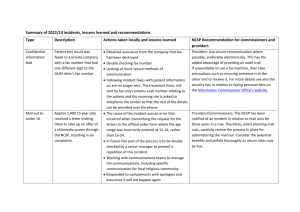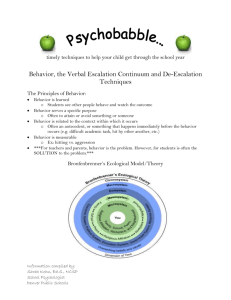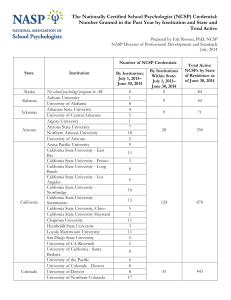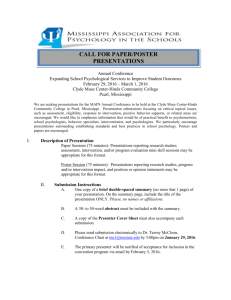The Obstacles and Opportunities in Advocating for NCSP Parity in Indiana
advertisement
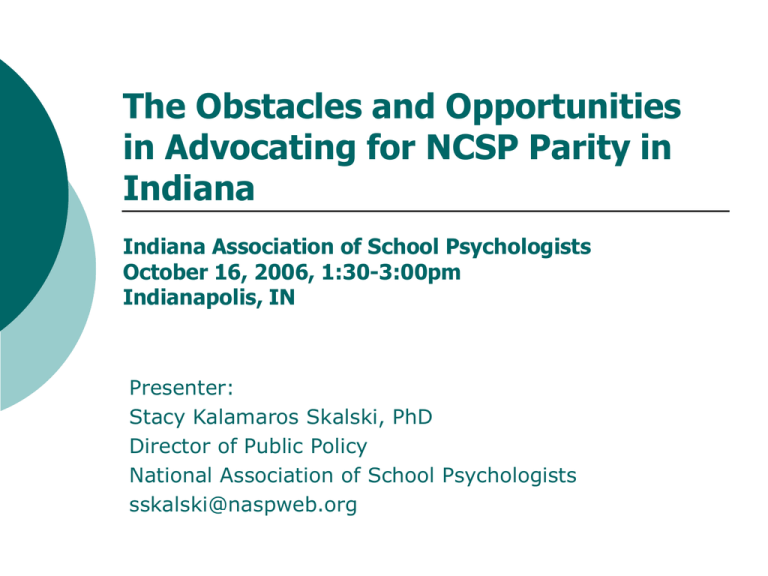
The Obstacles and Opportunities in Advocating for NCSP Parity in Indiana Indiana Association of School Psychologists October 16, 2006, 1:30-3:00pm Indianapolis, IN Presenter: Stacy Kalamaros Skalski, PhD Director of Public Policy National Association of School Psychologists sskalski@naspweb.org Agenda for this Session Overview of NCSP Parity Developing an advocacy strategy for NCSP Parity Understanding the obstacles and opportunities for Indiana Crafting Indiana’s advocacy message using existing data Planning for the future Advocate NCSP Parity/Skalski 2 What is NCSP Parity? Most states and many local school districts award stipends to teachers holding national board certification. NCSP parity refers to the need for school psychologists holding national certification to be treated equally to other educational professionals holding national certification. Advocate NCSP Parity/Skalski 3 Indiana’s School Academic Plan Public Law 221 established a grant system through the Indiana Department of Education to fund school improvement plans with the goal of improving student learning. The school improvement plan must include a professional development component and monies may be used for National Board Certification for teachers. See Indiana Code 20-20-31-12 Advocate NCSP Parity/Skalski 4 Comparing the NBPTS and the NCSP A comprehensive table comparing national certification across school professionals is available at http://nasponline.org/advocacy/certcomparison.pdf Advocate NCSP Parity/Skalski 5 General Goals of the NCSP To ensure a consistent level of training and field experience among school psychologists who hold the designation To promote uniform credentialing standards across state education agencies and other bodies who credential school psychologists Advocate NCSP Parity/Skalski 6 General Goals of the NCSP continued To link national accreditation of training programs (NCATE-NASP Approval) to a national credential (NCSP To promote Nationally Certified School Psychologists as those who have met national levels of training and who are committed to ongoing professional development and to following NASP ethics. Advocate NCSP Parity/Skalski 7 National Board for Professional Teaching Standards Proposition 1: Teachers are Committed to Students and Learning. Proposition 2: Teachers Know the Subjects They Teach and How to Teach Those Subjects to Students. Proposition 3: Teachers are Responsible for Managing and Monitoring Student Learning. Proposition 4: Teachers Think Systematically about Their Practice and Learn from Experience. Proposition 5: Teachers are Members of Learning Communities. Advocate NCSP Parity/Skalski 8 Pre-Requisites NBPTS NCSP To qualify for national certification candidates must have a bachelor’s degree, a state teacher certification, and 3 years teaching experience. To qualify for national certification NCSP candidates must have completed a minimum of 60 semester hours of graduate study in “School Psychology,” culminating in a MA, Ed.S., Ph.D. or other recognized postbaccalaureate degree. Supervised internship and a culminating 1,200 clockhour supervised internship. All other applicants must provide documents of having met these prerequisite standards. Advocate NCSP Parity/Skalski 9 Certification Requirements NBPTS NCSP Complete a portfolio which may include videotapes of classroom interactions or discussions, and collections of certain kinds of student work. An analysis of the teaching reflected in the videotape or student work is also required. The portfolio also documents teachers’ work outside the classroom with families, colleagues, and the community. The second component involves a written assessment which is comprised of four, 90-minute sessions. NASP Standards require that school psychology candidates demonstrate competency in 11 domains of professional practice as part of their formal training. Candidates must complete a NCSP Case Study. Complete a 1,200 clock-hour supervised internship of which 600 hours must be in a school setting. Achieve a passing score (660) on the National School Psychology Examination, administered by the Educational Testing Service (Praxis II: NTE Test #10400) Advocate NCSP Parity/Skalski 10 Renewal Requirements NBPTS NCSP The National Board for Professional Teaching Standards certification is good for 10 years. Renewal includes identifying areas for professional growth and demonstrating how growth has occurred. Demonstration of Professional Growth Experiences (PGE) may be accomplished with written responses to specific prompts, videotape demonstration, and/or submission of student work samples as evidence of direct impact on learning. NCSPs must engage in activities designed to maintain, expand, and extend their professional training and skills Specifically, each NCSP must be renewed every three years with 75 contact hours of continuing professional development (CPD) activities The hours must be fulfilled through a variety of NASP, state affiliate, or equivalent programs. Advocate NCSP Parity/Skalski 11 What is commonly heard about how NBPTS and NCSP compare? NCSP Challenges to Parity 3-year pre-requisite practice requirement “Entry level” Licensure Grandfathering Advocate NCSP Parity/Skalski 13 Arguments for NCSP Parity with NBPTS Graduate level training requirement. Specific coursework training components Supervised practice requirements are more extensive. Highest level of certification currently available. Ongoing professional development maintains high standards of practice Significant benefits to states with NCSP parity Advocate NCSP Parity/Skalski 14 Focus on the Benefits to States 1. 2. 3. Salary stipends for NCSPs attract more highly qualified school psychologist applicants Salary stipends demonstrate that the state or school district recognizes and acknowledges the importance of hiring school psychologists who meet nationally recognized standards for training and supervision. Salary stipends promote higher levels of knowledge and competency as NCSP school psychologists must engage in ongoing and meaningful continuing professional development. (NOTE: NCSPs share burden with district for professional development by active pursuit of the 75 CPDs required for renewal.) Advocate NCSP Parity/Skalski 15 Where are you more likely to get board policies? Districts with a current or future shortage of school psychologists Districts where teachers and administrators are awarded a stipend for NBPTS Districts where employment competition between school districts exists Districts with a good relationship between school district bargaining entities (i.e. union) and school mental health professionals. Advocate NCSP Parity/Skalski 16 Where are you more likely to get board policies? continued Districts where school psychologists are serving on district-level committees Districts where the benefits of school psychologists are well known Districts with a School Psychologist Coordinator/ Supervisor in Central Administration Advocate NCSP Parity/Skalski 17 Where are you more likely to get board policies? continued Districts where school psychologists have specific data supporting the cost-benefit of their services within the mission of schools. Districts interested in broadening the role of school psychologists from diagnostician to intervention/prevention specialist (Example: RTI) Districts where employee contract language refers to all certified employees as “teachers.” Advocate NCSP Parity/Skalski 18 Top 10 Advocacy Tips for Achieving NCSP Parity Tip 1: Convene a group of school psychologists interested in pursuing this issue. Key Question: Are you willing to commit to this process long term? Advocate NCSP Parity/Skalski 20 Tip 2: Begin your committee discussions by evaluating what your assets and obstacles are in getting NCSP parity passed. Key Question: What do we need? (State Laws? School Board Policies? Both?) Advocate NCSP Parity/Skalski 21 Tip 3: Collect and Evaluate Data Key Question: What do you have and what do you need? Advocate NCSP Parity/Skalski 22 Tip 4: Know who your allies are and be willing to build and nurture other essential relationships. Key Question: Who will be the champions of your cause? Advocate NCSP Parity/Skalski 23 Tip 5: Determine where there is “fertile ground” for NCSP Parity. Key Question: Are there existing school districts that support this cause or should support this cause due to a shortage or narrowly defined professional practices? Advocate NCSP Parity/Skalski 24 Tip 6: Prepare materials that clearly and simply explain why NCSP parity is essential and important for schools. Key Question: What existing data, resources, and materials supports our cause? Advocate NCSP Parity/Skalski 25 Tip 7: Talk to leaders who have tackled NCSP parity successfully and unsuccessfully in their state or local communities. Key Question: What are the major “lessons learned” about how to manage achieving NCSP parity? Advocate NCSP Parity/Skalski 26 Tip 8: Build a “grassroots” movement of practitioners committed to getting the message out and talking to key decision makers on the local and state level. Key Question: What infrastructure support (who, what, where, when) do you need to actively campaign for NCSP parity? Advocate NCSP Parity/Skalski 27 Tip 9: Teachers, students, and families need schools to recruit the best professionals and maintaining the highest standards for school psychological practice. Key Question: Can you show how NCSP parity promotes high quality services, the mission and purpose of schools, and the goals of NCLB? Advocate NCSP Parity/Skalski 28 Tip 10: Be resilient and patient in your quest. Alter your course as necessary with the expectation that you will achieve your goal. Key Quote: “Success is the ability to go from failure to failure without losing your enthusiasm.” Winston Churchill Advocate NCSP Parity/Skalski 29 NCSP Parity in State Law Louisiana Nevada Oklahoma Delaware Advocate NCSP Parity/Skalski 30 NCSP Parity in INDIANA Data References: Charvat, J. (2005, March) NASP Study: How many school psychologists are there? Communiqué, 33, 12-14. Curtis, M., Lopez, A., Batsche, G., & Smith, J. (2006, March) School Psychology 2005: A National Perspective. Paper presented at the annual meeting of the National Association of School Psychologists, Anaheim, CA Curtis, M., Lopez, A., Batsche, G., & Smith, J. Unpublished and unofficial results of the 2004-2005 NASP Membership Survey. Final results are expected soon! Stay tuned…. Advocate NCSP Parity/Skalski 31 Average Salary of School Psychologists 70000 60000 58955 52630 61857 60581 50174 Dollars 50000 40000 Series1 30000 20000 10000 0 Indiana Kentucky Ohio Illinois Advocate NCSP Parity/Skalski National 32 Average Number of Special Education Assessments Completed Annually 111 Number of Evaluations 120 92 100 80 60 40 81 64 61 57 47 35 44 37 Initial Evaluations Reevaluations 38 23 Total Assessments 20 0 Indiana Kentucky Ohio Illinois Advocate NCSP Parity/Skalski 33 2500 2179 2192 2000 1541 1500 1439 1037 1000 Series1 1000 500 Na ti o na l M ax Re c Il li no is hio O Ke nt uc ky 0 In dia na Number of Students Average Number of Students per School Psychologist Advocate NCSP Parity/Skalski 34 Number of Nationally Certified Training Programs 10 9 8 8 6 Series1 4 3 3 Indiana Kentucky 2 0 Ohio Advocate NCSP Parity/Skalski Illinois 35 Average Number of Individual Counseling Cases Number of Cases 12 10 8 6 Series1 4 2 0 Indiana Kentucky Ohio Advocate NCSP Parity/Skalski Illinois 36 Average Number of Consultation Cases Annually 45 40 35 30 25 20 15 10 5 0 41 36 33 19 Indiana Series1 Kentucky Ohio Advocate NCSP Parity/Skalski Illinois 37 Skill Utilization of School Psychologists in Indiana What we’re doing most of the time now: Special Education Assessment What we’re trained to do: Assessment Prevention activities Crisis intervention Behavioral interventions Academic interventions Consultation with teachers and parents Counseling / Direct Services In-services and Workshops for school staff & parents Research and Data Analysis Advocate NCSP Parity/Skalski 38 Recruitment Competition with Neighboring States Indiana has narrowly defined school psychology practice to the assessment of special education students. Broader role practiced in OH, IL, and KY Ratios of School Psychologist to Student are better in OH and IL. All states are sill above the national average and the maximum recommended NASP ratios. Graduates tend to stay in state to practice. More graduate training programs to meet the demand in OH and IL. Salaries in OH and IL are more on par with national average. Advocate NCSP Parity/Skalski 39 What Would NCSP Parity Cost in Indiana? Total number of NCSP’s in Indiana: 197 Percentage of School Psychologists working in public schools with NCSP: 50% Typical Annual Stipend of $2000 ESTIMATED PROGRAM COST: $394,000 First Year if only for Public School Employees: $197,000 Advocate NCSP Parity/Skalski 40 Other Data Needed? Vacancies (School District and State) Number of unfilled positions Number of positions filled by qualified and unqualified (temporary certification, contractual) personnel Current attrition rates due to job or role dissatisfaction Current attrition rates due to retirement Future Shortage of School Psychologist Average age of school psychologists Capacity of IN training programs to meet the future demand for school practitioners Advocate NCSP Parity/Skalski 41 Lessons Learned from Other Sates States need to build the capacity of school psychologists to become advocates (i.e. PPI) An advocacy agenda (legislative or policy) for the state organization is essential Strategies for accomplishing the advocacy agenda must be developed Coalition building is fundamental Information must be disseminated in a very timely fashion Targeting key legislators/policy makers to enlist their support of legislation is critical Advocate NCSP Parity/Skalski 42 NCSP Questions and Resources Joan Bohmann NASP Director of Professional Standards and Continuing Professional Development jbohmann@naspweb.org Sawyer Hunley National School Psychology Certification Board, Chair sawyer.hunley@notes.udayton.edu NASP Website: http://www.nasponline.org/certification/index.html Advocate NCSP Parity/Skalski 43 NCSP Parity Advocacy Questions & Resources Stacy Kalamaros Skalski NASP Director of Public Policy Email: sskalski@naspweb.org Candis Hogan Oklahoma Delegate and GPR Committee, Central Region Leader hcandis@juno.com NASP website: http://www.nasponline.org/advocacy/NCSPstateinitiatives .html Advocate NCSP Parity/Skalski 44 Final Thoughts, Questions, Discussion



